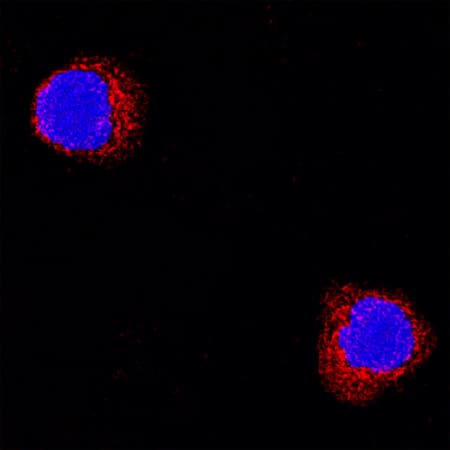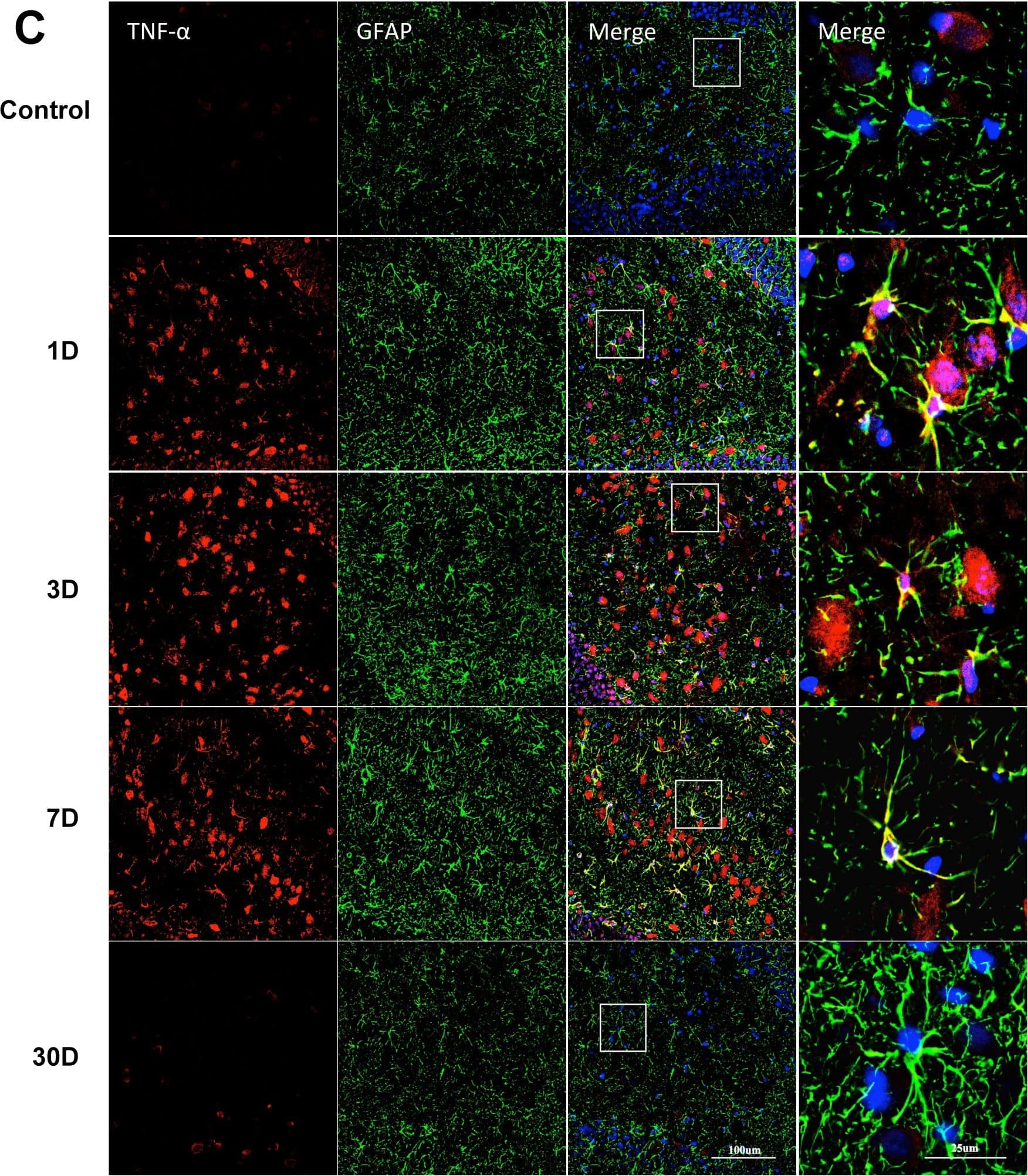Rat TNF-alpha Antibody
R&D Systems, part of Bio-Techne | Catalog # AF-510-NA


Key Product Details
Species Reactivity
Validated:
Cited:
Applications
Validated:
Cited:
Label
Antibody Source
Product Specifications
Specificity
Clonality
Host
Isotype
Scientific Data Images for Rat TNF-alpha Antibody
Cytotoxicity Induced by TNF-alpha and Neutralization by Rat TNF-alpha Antibody.
Recombinant Rat TNF-a (Catalog # 510-RT) induces cytotoxicity in the the L-929 mouse fibroblast cell line in a dose-dependent manner (orange line), as measured by Resazurin. Cytotoxicity elicited by Recombinant Rat TNF-a (0.25 ng/mL) is neutralized (green line) by increasing concentrations of Goat Anti-Rat TNF-a Antigen Affinity-purified Polyclonal Antibody (Catalog # AF-510-NA). The ND50 is typically 0.15-0.75 µg/mL in the presence of the metabolic inhibitor actinomycin D (1 µg/mL).TNF‑ alpha in Rat Splenocytes.
TNF-a was detected in immersion fixed rat splenocytes using Goat Anti-Rat TNF-a Antigen Affinity-purified Polyclonal Antibody (Catalog # AF-510-NA) at 15 µg/mL for 3 hours at room temperature. Cells were stained using the NorthernLights™ 557-conjugated Anti-Goat IgG Secondary Antibody (red; Catalog # NL001) and counterstained with DAPI (blue). Specific staining was localized to cytoplasmic. View our protocol for Fluorescent ICC Staining of Non-adherent Cells.Detection of Porcine TNF-alpha by Immunocytochemistry/ Immunofluorescence
Astrocytes activity and GFAP/TNF-alpha double staining in the DG area.Astrocyte activity was measure with GFAP immunofluorescence. Representative photomicrographs show control and LPS-injected rats at different time points up to day 30. (A) Densitometry of GFAP fluorescence intensity was up-regulated from day 1 to day 7. Following LPS injection, astrocytes showed changes in morphology, which was recognized by decreased ramification and hypertrophy of the soma. (B) Double fluorescence staining of GFAP and TNF-alpha in hippocampal astrocytes. The ratio of TNF-alpha positive astrocytes in total astrocytes (GFAP-positive cells) was significantly increased from day 1 and peaking on day 7. Pictures show DG area, data are expressed as mean ± standard error of the mean (n = 4) and compared by 1-way analysis of variance followed with Boferroni post hoc analysis, **p0.01, ***p0.001 vs Control. Image collected and cropped by CiteAb from the following open publication (https://dx.plos.org/10.1371/journal.pone.0106331), licensed under a CC-BY license. Not internally tested by R&D Systems.Applications for Rat TNF-alpha Antibody
Immunocytochemistry
Sample: Immersion fixed rat splenocytes
Western Blot
Sample: Recombinant Rat TNF-alpha (Catalog # 510-RT)
Neutralization
Formulation, Preparation, and Storage
Reconstitution
Formulation
Shipping
Stability & Storage
Background: TNF-alpha
Tumor Necrosis Factor Alpha (TNF-alpha) also known as Cachectin and TNFSF2, is the prototypic ligand of the TNF superfamily. It is a pleiotropic molecule that plays a central role in inflammation, apoptosis, and immune system development. TNF-alpha is produced by a wide variety of immune and epithelial cell types (1, 2). Rat TNF-alpha consisits of a 35 amino acid (aa) cytoplasmic domain, a 21 aa transmembrane segment, and a 179 aa extracellular domain (ECD) (3). Within the ECD, rat TNF-alpha shares 94% aa sequence identity with mouse and 69% - 76% with bovine, canine, cotton rat, equine, feline, human, porcine, and rhesus TNF-alpha. The 26 kDa type 2 transmembrane protein is assembled intracellularly to form a noncovalently linked homotrimer (4). Ligation of this complex induces reverse signaling that promotes lymphocyte co-stimulation but diminishes monocyte responsiveness (5). Cleavage of membrane bound TNF-alpha by TACE/ADAM17 releases a 55 kDa soluble trimeric form of TNF-alpha (6, 7). TNF-alpha trimers bind the ubiquitous TNF RI and the hematopoietic cell-restricted TNF RII, both of which are also expressed as homotrimers (1, 8). TNF-alpha regulates lymphoid tissue development through control of apoptosis (2). It also promotes inflammatory responses by inducing the activation of vascular endothelial cells and macrophages (2). TNF-alpha is a key cytokine in the development of several inflammatory disorders (9). It contributes to the development of type 2 diabetes through its effects on insulin resistance and fatty acid metabolism (10, 11).
References
- Idriss, H.T. and J.H. Naismith (2000) Microsc. Res. Tech. 50:184.
- Hehlgans, T. and K. Pfeffer (2005) Immunology 115:1.
- Estler, H.C. et al. (1992) Biol. Chem. Hoppe-Seyler 373:271.
- Tang, P. et al. (1996) Biochemistry 35:8216.
- Eissner G. et al. (2004) Cytokine Growth Factor Rev. 15:353.
- Black, R.A. et al. (1997) Nature 385:729.
- Moss, M.L. et al. (1997) Nature 385:733.
- Loetscher, H. et al. (1991) J. Biol. Chem. 266:18324.
- Clark, I.A. (2007) Cytokine Growth Factor Rev. 18:335.
- Romanatto, T. et al. (2007) Peptides 28:1050.
- Hector, J. et al. (2007) Horm. Metab. Res. 39:250.
Long Name
Alternate Names
Entrez Gene IDs
Gene Symbol
UniProt
Additional TNF-alpha Products
Product Documents for Rat TNF-alpha Antibody
Product Specific Notices for Rat TNF-alpha Antibody
For research use only


